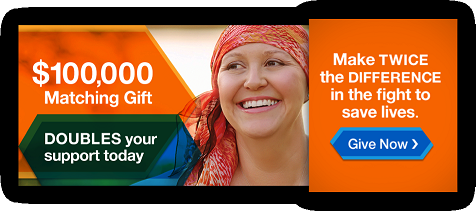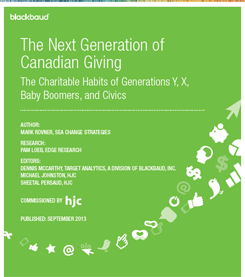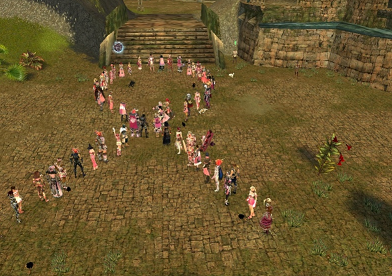
An Integrated Year-End Appeal Worth Emulating
This article was written by guest blogger Brock Warner. Brock is a fundraiser for War Child Canada & US, as well as a TEDx speaker on philanthropy, a blogger, and volunteer with the AFP Greater Toronto Area chapter.
 A helping hand can give a big boost to your results. Such is the case for the Fred Hutchinson Cancer Research Center (Fred Hutch) team, and their 2012 year-end $100,000 matching gift campaign for cancer research.
A helping hand can give a big boost to your results. Such is the case for the Fred Hutchinson Cancer Research Center (Fred Hutch) team, and their 2012 year-end $100,000 matching gift campaign for cancer research.
Through pioneering research, Fred Hutch physicians and scientists have forged breakthroughs in nearly every field of cancer research. This world-renowned nonprofit research organization is working to advance the progress of cancer research to eliminate cancer and related diseases as causes of human suffering and death. Fred Hutch is dedicated to promoting the importance of scientific research as a matter of life and death for those diagnosed with this terrible disease.
As part of their year-end fundraising strategy, Fred Hutch launches a matching gift campaign each December. Internally, Keri Balmer, senior manager of annual giving, made a case to her digital team to launch an integrated campaign that would utilize all available channels to make the most out of this fundraising ask. To help make it possible, Grizzard Communications Group was enlisted for support.
There were two great opportunities at hand – first, the opportunity to leverage the $100,000 matching gift. The second, to gain momentum from a recently launched awareness campaign to help promote online fundraising opportunities. Keri thought the campaign could generate much more revenue than in years prior.
Realizing this was an untapped opportunity to maximize the Fred Hutch matching gift offer, Grizzard developed a strategy to include a push online. A three-part digital plan was developed to integrate with the direct mail effort and the recent awareness campaign. The digital components included:
- A five-stage email strategy that focused on the matching gift opportunity and created urgency to give before year-end.
- A banner ad was added to the Fred Hutch home page.
- A light-box (pop-up) that activated as soon as the home page loaded.
So, was it worth it? The campaign results are impressive enough to speak for themselves:
- Light box: $90,949
- Banner: $60,385
- Email: $20,675
- Direct Mail: $207,810
- TOTAL: $379,819
The integrated campaign was an overwhelming success for Fred Hutch at year-end, securing their $100,000 matching gift and ending the year on a very high note. Congratulations to everyone at Fred Hutch.
So, have you started planning your year-end ask yet?
Share, Like and Post | | Article Link | CommentThoughts from BBCon 2013: Accelerating Fundraising through Integrated Marketing
 This week’s Blackbaud Conference (BBCON) had “Accelerate” as its title and theme. As I led a session on integrated fundraising, talked to people at our booth, and chatted in the halls, I was struck by the sobriety of this year’s conference.
This week’s Blackbaud Conference (BBCON) had “Accelerate” as its title and theme. As I led a session on integrated fundraising, talked to people at our booth, and chatted in the halls, I was struck by the sobriety of this year’s conference.
And I’m not talking about alcohol whatsoever.
What I’m talking about is the fact that nonprofit and partner participants were having conversations about accelerating their fundraising, but in thoughtful, thorough, and critically minded ways.
There were many sessions on how to use data to more effectively take care of our existing donors. There were sessions that were trying to leverage market research to make limited marketing dollars more effective. And, there were sessions of cautious tales learned from nonprofits that had tried something new and cautioned others on how to do it better next time.
I think part of this more thoughtful, more conservative, approach to improving fundraising is being driven by the recession. But, it might also be a cultural shift in how we view the potential of technology.
There were wonderful new mobile apps, cloud solutions, and more to excite any fundraiser, but the conversation about new technology was about how to leverage it to do existing fundraising and marketing more effectively. There was less of the shiny new syndrome and more maturity in the approach to use technology in fundraising.
The concept of integrated fundraising sat at the center of the conversation. From the session on The Past, Present, and Future of Integrated Marketing to Turning Peer to Peer Fundraising Benchmark Data in Action to Snag Em for Life – Tag Em in eTapestry and many more, the conversations were about bringing everything together to improve the donor journey. It was a truly integrated conversation in the many rooms at the conference.
It’s about time. And not a moment too soon as donor attrition rises inexorably, but not permanently if we get on it now.
I’ll call this the age of ambitious caution in which we want to carefully transform our fundraising to transform the world around us. And BBCON captured it perfectly.
As we move away from BBCON, how do organizations find the training, inspiration, and cautionary guidance over the next year? Here are two places where you can learn, share, and help integrated marketing move forward:
- The first is the 1st Annual IMAB Virtual Conference in November 2013. Watch this blog in coming weeks for details!
- The 9th Annual Bridge to Integrated Marketing and Fundraising Conference – July 9-11, 2014 (Note that the call for papers deadline is this Friday, October 4!)
Five Ways for Nonprofits to Approach Integrated Marketing on a Budget
 Integrated marketing should reduce costs and increase return on marketing investment (those are the reasons we -- the IMAB -- exist). But all change involves some friction, and what follows are some ways your nonprofit can increase the results of integrated marketing while you counter arguments that “we can’t afford that right now.”
Integrated marketing should reduce costs and increase return on marketing investment (those are the reasons we -- the IMAB -- exist). But all change involves some friction, and what follows are some ways your nonprofit can increase the results of integrated marketing while you counter arguments that “we can’t afford that right now.”
- Engage in ongoing conversations with supporters, not a string of disconnected monologues:
- Tell people what’s new with little Timmy, whose classroom was the subject of your last fundraising appeal.
- Re-use enough pictures so they remember.
- Highlight a different aspect of the same story, or segue cleanly to another story that focuses on another fundraising priority.
- Write all your copy, and do all the design, at one time:
- Hold an Integrated Strategy Session, where you discuss the key themes of a campaign, and then ask how it can be implemented in each channel.
- Writing three supporting email messages is much easier right after the direct mail fundraising copy has been planned and written.
- The social media posts, face-to-face and phone scripts, and subway signs all can flow from the same main points of the grant request or the direct mail package.
- Re-use successful campaigns. Why did Coca Cola get away from “I’d like to teach the world to sing”? Come to think of it, why did Coca Cola get away from Coke itself? (remember the “New Coke” debacle?) The biggest waste in advertising is to change advertising that still works. Remember that great fundraising campaign from two years ago? Dust it off, update the story, and tell it again. It touched people. Let them be touched again. Thinking that your donors remember everything you send them is pretty egotistical.
- Tell all your supporters everything. Tell your event donors about your grant applications. Tell your direct mail donors about your advocacy efforts. Let your donors know they’re part of a bigger picture, and they’re more likely to find new ways to support you.
- Use free media.
- Update social media regularly, and especially during campaigns. Not only is Facebook free, everyone knows how to find your information there (that’s not always true with a nonprofit website).
- Link your website to your Facebook feed, so that updates on social media appear on your site. That’s a lot cheaper than updating your site several times a day.
- Feed information to bloggers who cover the same issues as your campaign. Bloggers have reach and influence you don’t.
There are many other ways to implement integration, but five is a good number for a blog post. What are your additional ideas?
Share, Like and Post | | Article Link | CommentHow Do Your Donor's Giving Habits Compare with Canadian's?
Whether you’re a fundraiser in the U.S., Canada, or anywhere else, knowing how donors really give should inform your fundraising strategy.
For example, imagine that your organization has a declining donor base. You need to find new donors, and have decided to focus on acquiring younger ones. Your organization agrees to focus on Gen Ys. Your board approves a text-to-give campaign, and you’ll now be focusing on social media – you even hire a social media guru. This sounds wise since Gen Ys are future donors, and they’re attached to their smart phones. Right? Maybe not.
 The Next Generation of Canadian Giving 2013
The Next Generation of Canadian Giving 2013
hjc, Blackbaud, Edge Research, and Sea Change Strategies recently studied the giving habits and communication preferences of four generations of Canadian donors and published their findings in a report called The Next Generation of Canadian Giving 2013. The study looked at the philanthropic habits of the following generations of Canadians:
- Generation Y (or Gen Y, born 1981 - 1995)
- Generation X (or Gen X, born 1965 - 1980)
- Baby Boomers (or Boomers, born 1946 - 64)
- Civics (born 1945 or earlier)
And, the results of the study may surprise you.
For starters, Gen Xs are a quickly rising force in philanthropy in Canada. Gen Ys in Canada hardly ever text to donate. And, social media isn’t viewed as an appropriate fundraising channel for any age group.
And, that’s just the beginning. Because The Next Generation of Canadian Giving 2013 builds on a similar study conducted in 2010, and was based on similar studies into the habits and preferences of American donors, the report not only identifies trends in Canadian giving, but also provides insight into the differences between Canadian donors and their American counterparts. For example, giving support for advocacy organizations in the U.S. is about double that in Canada, and support for military troops/veteran organisation is about three times greater in the U.S. However, Canadians are far more likely to support health and children’s charities than their American counterparts, and growth in Canadian Gen X giving outpaced that in the U.S.
As communication and giving habits continue to change, solid data about donors’ behavior is especially important. Before you start your next campaign, be sure you know how donors give and how they prefer to communicate, and you’ll be well-positioned to engage with them more effectively.
Share, Like and Post | | Article Link | CommentWhat Grand Theft Auto 5 Has to do With Fundraising
With the release of Grand Theft Auto 5 and the expectation for it to sell over $1 billion dollars in sales (on a cost of $280 million to create), it’s time to talk about computer gaming and the influence of the digital gaming culture on the charitable sector.
Why Pay Attention to Gaming?
- Over 70% of Western households play computer, digital, or video games.
- The average age of a game player is 37.
- Women make up 42% of game players.
Digital gaming is the de facto leisure activity by size of the industry. In 2005, it surpassed the movie industry in sales. In 2008, it surpassed the music industry. And today, the digital gaming industry is larger than the book, music, and movie industry combined.
The majority of your Gen Y and Gen X donors and a sizeable number of Boomer donors are playing digital games on an iPhone, Xbox, Wii or computer.
Gaming is culture. It is us, and it is your donor base.
Using Gaming Elements Outside of Games
Wait! Before you go out and create a game -- I wouldn’t recommend that in a million years (it would be like me telling a charity to make a feature film -- ridiculous!), let’s look at the principle of gaming that can help you enhance your fundraising and relationships with your donors.
It may sound silly, but this approach of taking elements of a game and putting them to use in other areas (the cause of your charities marketing/fundraising objectives) is called “Gamification”. You see well-thought-out gamification in air miles programs, for example. Anyone in Star Alliance or One World loyalty programs deals with:
- point systems tied to rewards
- levels like gold, silver, bronze
- bonuses for reaching different levels
That’s gamification in action.
How can a charity apply gamification?
We already see it done in pledge events. Rewards and different levels for event registrants in their fundraising is offered across the sector. Could it be done more effectively? Yes. Read up on gamification and see how you can do a better job applying the principles to your next fundraising campaign. Definitely check out these 10 examples of how organizations are using gaming to further their mission.
How do you leverage gamers to raise money for you while they enjoy their favourite games?
First, find popular games and the place where gamers who are inclined to support nonprofits might congregate -- those places do exist! One such place where gamers come together to support charities is http://www.childsplaycharity.org/. Here, individual charities tap into games to raise money. The Make-A-Wish Foundation USA raised over $1 million in one day with the sale of a virtual pet within the popular game, World of Warcraft.
Of course, you have to be open to gamers who want to raise money for your organization. Or you’ll have a missed opportunity like this:
The Canadian Cancer Society, Saskatchewan Division received a call from a supporter (let’s call this person Casey), who also played the game, Guild Wars. Casey wanted to raise money within the game itself for the Society, but without a policy in place, nor an understanding culture for gamers, the Society had to turn Casey away.
 But that didn’t stop Casey, who found the Society’s online tools to create a fundraising page. Casey then leveraged online gaming friends to raise thousands of dollars for breast cancer research – in one day! To the right is a screen capture of the virtual gamers forming a ribbon shape in support of the online fundraising efforts.
But that didn’t stop Casey, who found the Society’s online tools to create a fundraising page. Casey then leveraged online gaming friends to raise thousands of dollars for breast cancer research – in one day! To the right is a screen capture of the virtual gamers forming a ribbon shape in support of the online fundraising efforts.
In Conclusion
Gaming is the primary form of entertainment with younger and middle-aged donors, regardless of gender. Gaming is deeply embedded into our culture, and gamification presents a significant opportunity to organizations. Every charity needs to:
- Choose someone to become the point person on gaming culture. Most likely, a gamer themselves.
- Foster a culture that respects gaming needs and gamers’ desires.
- Create a web page welcoming donors/supporters who are gamers, and offer online personal page fundraising tools that they can take advantage of.
- For larger organizations, you may want to look for gaming companies to support your mission.
And finally, every fundraiser needs to play digital games if they don’t already. There’s a game out there for you. Find one so you can truly understand this dominant activity. It will help you find ways to use gaming culture and gamification to improve current fundraising practices, and help you find ways to nurture and support gaming supporters so they can leverage their gaming passion alongside their belief in your cause.
Share, Like and Post | | Article Link | Comment

















